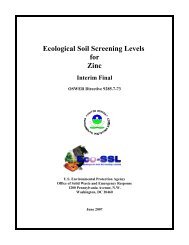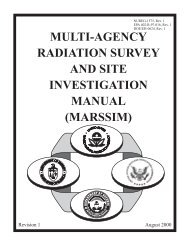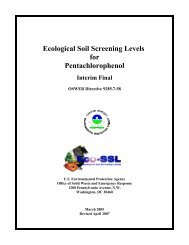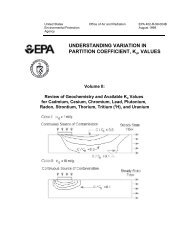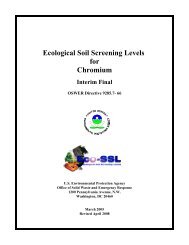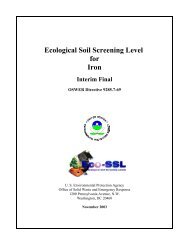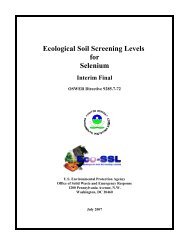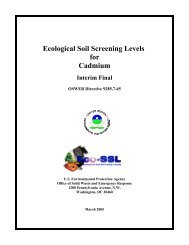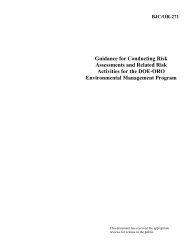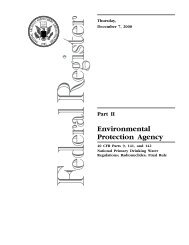Nickel - The Risk Assessment Information System
Nickel - The Risk Assessment Information System
Nickel - The Risk Assessment Information System
Create successful ePaper yourself
Turn your PDF publications into a flip-book with our unique Google optimized e-Paper software.
<strong>Nickel</strong> is released to the environment through the extraction, processing and use of nickel<br />
compounds (HSDB). <strong>The</strong> single largest use of nickel is in the manufacture of stainless steels<br />
(Alloway, 1990). <strong>Nickel</strong> is also used in the production of alloys with other metals such as iron,<br />
copper, chromium, and zinc (ATSDR, 1988; HSDB). Other major uses are in electroplating<br />
alloys, nickel-cadmium batteries, electronic components, fuel cells, specialty ceramics, magnets,<br />
specialty chemicals, filters for gases, hydrogenation of fats, petroleum products, preparation of<br />
colored pigments and for color stabilization of color copy paper (ATSDR, 1988; Alloway, 1990).<br />
<strong>Nickel</strong> may also be released from natural sources, such as volcanoes, windblown dusts, the<br />
weathering of rocks, forest fires, and decaying vegetation (Davies, 1974; HSDB).<br />
In the atmosphere, nickel is expected to exist in the particulate phase and is released to soils<br />
through wet and dry deposition. <strong>The</strong> species of nickel present in deposition include soil minerals,<br />
oxides and sulphates (Alloway, 1990). <strong>The</strong> largest anthropogenic sources of nickel to the<br />
atmosphere result from the burning of fuel and residual oils followed by diesel exhaust, the<br />
combustion of coal and nickel mining and smelting (Alloway, 1990).<br />
Background concentrations reported<br />
for many metals in U.S. soils are<br />
described in Attachment 1-4 of the<br />
Eco-SSL guidance (U.S. EPA, 2003).<br />
Figure 2.1 provides a plot of the<br />
typical background concentrations of<br />
nickel in U.S. soils in the eastern and<br />
western portions of the country.<br />
In soils, nickel may be present as<br />
soluble compounds including<br />
chlorides and nitrates, and insoluble<br />
compounds such as oxides and<br />
sulfides. Soluble nickel compounds<br />
tend to exhibit greater mobility than<br />
insoluble nickel compounds (Dean,<br />
1985; HSDB). <strong>The</strong> degree of mobility<br />
is influenced by the formation of complexes in the presence of organic<br />
substances and sulfates (Anderson and Christensen, 1988). <strong>The</strong> distribution<br />
of nickel between solid and solution phases is primarily controlled by pH<br />
with secondary factors being clay content, and the amount of hydrous iron<br />
and manganese oxides. Soluble nickel increases with decreases in pH.<br />
Increases in metal loading and cation exchange capacity (CEC) increase the<br />
amount of metal adsorbed by soil (Alloway, 1990). Due to low vapor<br />
Conc (mg/kg dw)<br />
60<br />
50<br />
40<br />
30<br />
20<br />
10<br />
0<br />
East West<br />
Figure 2.1 Typical Background<br />
Concentrations of <strong>Nickel</strong><br />
in U.S. Soils<br />
Maximum<br />
pressures, most nickel compounds are not expected to volatilize from moist or dry soil surfaces,<br />
with one notable exception being nickel carbonyl (Ohe, 1976; HSDB). <strong>The</strong> concentration of<br />
nickel in plants generally reflects the concentration in soil although the relationship is more<br />
related to soluble and exchanged forms of nickel. Factors that increase solubility and<br />
Eco-SSL for <strong>Nickel</strong> 2<br />
March 2007<br />
95th<br />
75th<br />
50th<br />
25th<br />
5th Percentile



